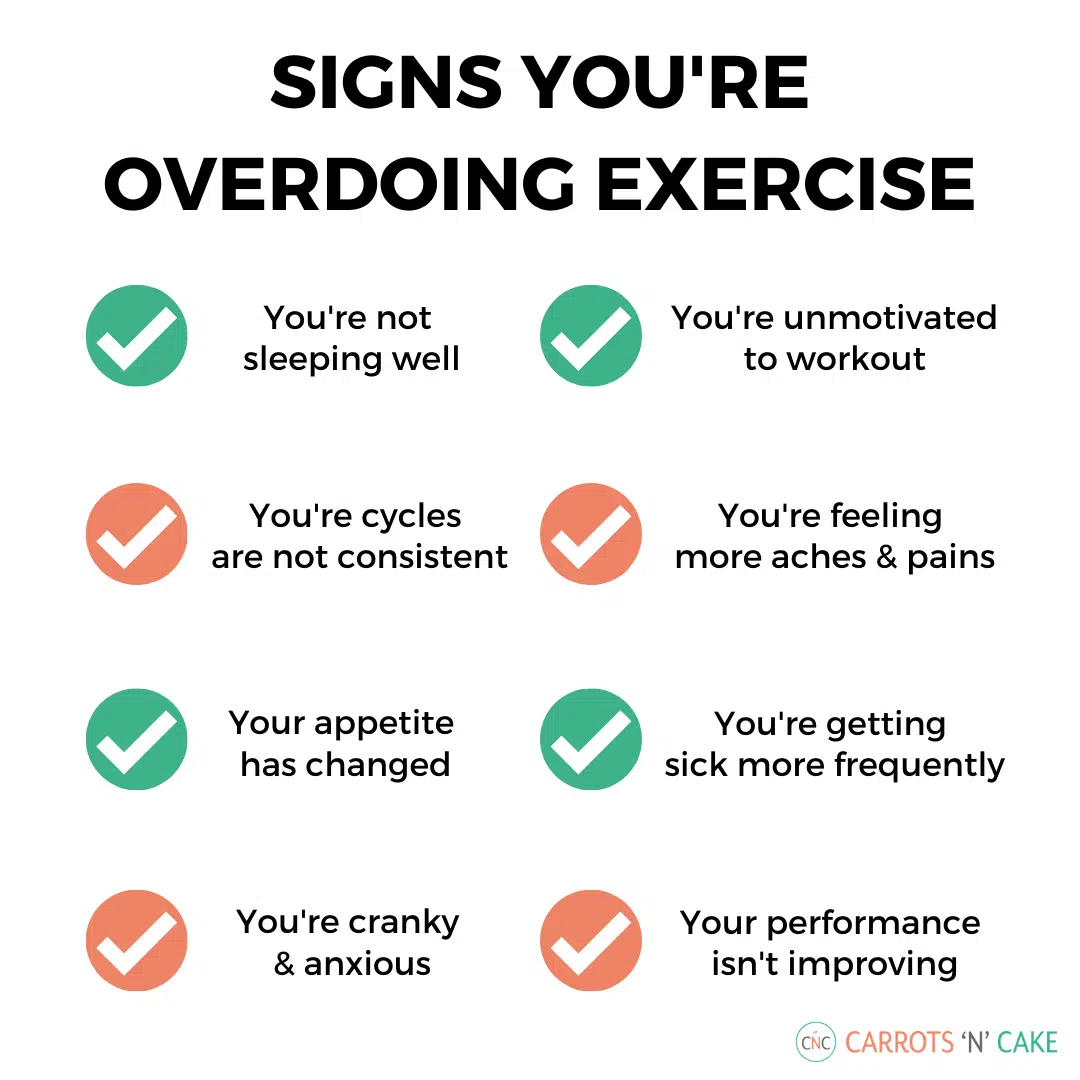Many of the women who come to me for one-on-one nutrition and group coaching come to me with hormonal imbalances. Many of these imbalances are a result of overtraining. They’ve adopted the ‘all or nothing’ approach to their nutrition and fitness, which has left their hormones wrecked and in much need of repair and rejuvenation.
What is Overtraining Syndrome?
Overtraining and overtraining syndrome is a real thing, and it’s not reserved for professional or extreme athletes. Everyday women, who are actively pursuing their own weight loss goals, often fall into the overtraining trap. They go into the gym seeking results with hours and hours (and hours) of training. They do not allow their bodies to rest and recover between workouts, and they end up damaging their hormones, and their bodies.
I don’t overtrain (anymore), and I don’t recommend it for my clients either. Are you overtraining?
First, let’s identify the symptoms of overtraining syndrome. These include:
- insomnia
- fatigue
- headaches
- frequent colds, infections, and sore throats
- moodiness or irritability
- anxiety and panic attacks
- change in menstrual cycle
- numbness or tingling in the hands or feet
- repeated injuries, body aches, and pains
If you’re experiencing any of these symptoms on a regular basis, you may be overtraining. Overtraining impacts your hormones in negative ways and can cause your weight loss to stall, or even worse, cause it to reverse itself, meaning weight gain. Yikes!
The three main ways overtraining affects your hormones
Thyroid hormones
When you’re overtraining, your body intentionally tries to slow your metabolism as a response to metabolic stress caused by excessive exercising. This means the body burns calories more slowly causing weight loss to stall. Your freeT3 (free Triiodothyronine) levels dip and can cause additional symptoms such as extreme fatigue, body anxiety, dry skin, thinning hair, constipation, numbness, and chills.
Cortisol and adrenal hormones
Overtraining can also impact the levels of cortisol and adrenaline. The stress placed on the hypothalamic-pituitary-adrenal (HPA) axis causes our hormones to become ‘out of whack’ and irregular levels of cortisol and adrenaline can create feelings of fatigue and anxiety.
Ovulation and progesterone levels
Has your menstrual cycle been wonky lately? Early menses, short menses, elongated, heavy, or light menses? All of the hormonal systems are connected and when the body is over-exerted, your cycle will be impacted. If you are suffering from overtraining syndrome, your cycle may be longer than usual, or you may experience more cramping, or you may miss a cycle completely.
Overtraining happens to the best of us. I mean, we all want results, right? I completely understand the desire to work hard. So, how can you get effective results without overtraining?
How to reverse and move on from overtraining
To reverse overtraining, I recommend first assessing your current workout and nutrition routine and making modifications if either one is too intense. Next, ensure you’re living a balanced lifestyle – sleeping well, managing stress (this is HUGE), and eating well (getting the right amount of protein, carbohydrates and healthy fats in your diet). Lastly, you can even include hormonal testing and supplementation under the advice of a health care professional. Once you’re well on the way toward recovery I recommend taking steps to move forward efficiently, without falling back into the same patterns.
On the exercise front… cross-training, eating the proper foods, getting sufficient sleep, and reducing cortisol are all essential for ensuring you avoid falling into the overtraining syndrome trap again. Include breaks, such as only exercising 2-4 days a week, and limiting their length and intensity to keep from overtraining. Strength training and leisure walking are your friends!
Most importantly moving forward, choose a workout routine that includes strength training and doesn’t last more than an hour. Use dumbbells to increase the metabolic effect of your workout and stay consistent. If that means 30 minutes, four times a week, great! Trust me, you don’t need crush it in your workouts every single day to get great results, especially if you’re using the right workout and nutrition combo.
In my new program, #StrongMadeSimple, you’ll receive all the tools you need to begin reversing the effects of overtraining and begin seeing the results you’ve been working so hard to achieve. #StrongMadeSimple includes 24 full-length workouts, all 30 minutes or less, and is designed to increase strength and definition. I mean, you want to actually look like you work out, don’t you?!
#StrongMadeSimple is a total body strength training solution for building muscle and burning fat, and it’s available right now. Click THIS LINK to learn more about #StrongMadeSimple and join today!














